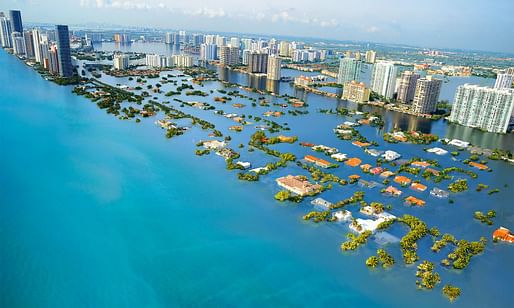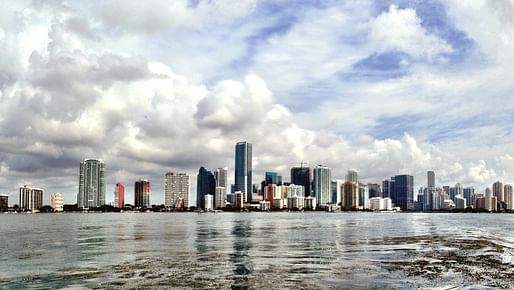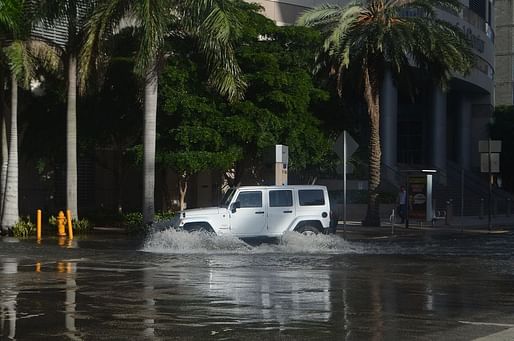

The City of Miami has published a draft of its Stormwater Master Plan; a $3.8 billion plan to be enacted over the next 40 years, seeking to mitigate the impact of rising sea levels on the city. The plan sets out a wide portfolio of measures, from stormwater pumps and sea walls to more novel approaches such as floating neighborhoods and streets converted into canals.
The report sets out both short and long-term strategies for the city’s defense from rising sea levels. Near-term resiliency measures, with a 20-to-50-year planning horizon, include both structural and non-structural actions, encompassing everything from infrastructure construction to reformed insurance models. The plan proposes an upgrade to building code strategies, including minimum structure finish-floor levels informed by predicted water surface levels, and a requirement for piled or stilted structures, both buildings and roadways, to consider future sea level rise.

Along with stricter standards on new infrastructure, the plan calls for the raising of existing critical infrastructure to appropriate resiliency heights. This would be achieved though building new containment walls and stairs at entrances, adding new stories, and relocating from ground floor levels. City public works infrastructure would be heightened by adding new concrete pads and slabs, watertight hatches, and raising electrical equipment. The plan also states it may be appropriate to consider the purchase, removal, and relocation of vulnerable structures of infrastructure.
Other short-term measures include building traditional “grey infrastructure” such as seawalls and breakwaters, with a focus on areas that lack existing infrastructure, have fallen into disrepair, or are too low for predicted sea levels. Alongside grey infrastructure, the plan calls for the creation, protection, and strengthening of natural infrastructure such as coral reefs, oyster reefs, and marshes that play an important role in dissipating wave energy and blocking surge flow.

In addition to these short-term measures, the plan sets out a range of long-term resiliency measures, to be enacted by the end of the century. The report describes these measures as “conceptual in nature” which could “significantly affect the entire South Florida population, way of life, and local economy.” These include raising the lowest-lying elevations of Miami city, in a phased reconstruction of most structures and roadways, and the excavation of the lowest-lying areas to create large, dedicated stormwater storage capacity.
Other long-term measures call for “co-existing with water” which would modify the basic design of the city. These could include elevated pile roadway networks, elevated houses, floating neighborhoods and platform communities in low-lying areas, and the conversion of low-lying streets to an interconnected canal system for transportation and flood control.

“The most common question I get asked is whether Miami is going to be here in 50 years, whether it’s going to be here in 100 years,” said Miami Mayor Frances Suarez while announcing the plan. “This is the beginning of having a comprehensive plan to answer that question in the affirmative.”
10 Comments
The Gulf and or the Sea of Cortez can use filter fabric geotextiles to terraform Kofa National Monument into a river valley. It will help the worldwide rising sea levels from the Bay of Bengal to the new islands and harbors across the world. Agricultural development will easily take the water and return it to the earth.
wheres the full plan? this is the executive summary
Hold back the Atlantic Ocean and hurricanes? No problem!
Money money money. Did you ever consider backing away from the coastline? Oh! We're not going to do that we would lose too much money. You cannot control that much ocean. Get over yourselves .
Miami is a port city, and not just for cruise ships. Kind of hard to back away from the water if you are a port. Before baking some pie in the sky I would hire some people from Rotterdam and Amsterdam where they have successfully been dealing with the issue for 200 years or so. But that's just me.
Effective solutions are anathema to capitalism. I'm waiting for Musk to propose equalizing the Atlantic and Pacific oceans through drainage tunnels drilled from coast to coast.
I've always thought Boston should dam off the Massachusetts bay to set themselves up as for the next 500 years.
Drain the ocean
the irony is that every development idea to combat rising sea levels just accelerates climate change
Spend 3.8 billion dollars on slowing climate change.
Block this user
Are you sure you want to block this user and hide all related comments throughout the site?
Archinect
This is your first comment on Archinect. Your comment will be visible once approved.